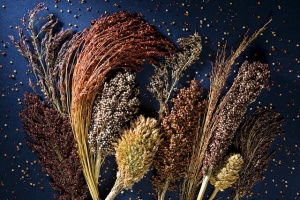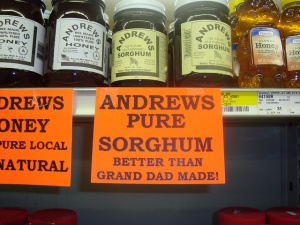
Drought tolerant crop
To learn more about sorghum, we started with one of the nation's leading experts on the crop – Jeff Dahlberg, director of University of California's Kearney Agricultural Research Center in Parlier, CA. Jeff previously served as the USDA Agricultural Research Service (ARS) curator for sorghum. He was research director for the National Sorghum Producers and the United Sorghum Checkoff Program. In 2011, Jeff was recipient of National Sorghum Producers' Outstanding Achievement Award. In other words, he knows his sorghum.

“The versatility of sorghum allows it to be used in a wide range of food, feed and bioenergy products,” Dahlberg said. “The plant has inherent drought tolerance and can thrive in growing conditions that would seem too harsh for other crops. With more research and outreach, sorghum could be an extremely valuable crop for helping to feed the world in the future as we deal with limited inputs and water.”
Dahlberg first became interested in sorghum as a Peace Corps volunteer in Niger, a land-locked African country that consistently is one of the lowest-ranked in the United Nations' Human Development Index (HDI).
“Niger's farmers relied on rainfall to produce their major staples and sorghum was a crop that did well under limited rainfall,” Dahlberg said. “The crop was extremely versatile in that the grain was used for human food production, the leaves were harvested for animal feed and the stalks, many of which could be as tall as 12 feet, were used as building material. The versatility and the toughness of the crop got me interested in researching what made this crop work.”
For an interesting look at why farmers are considering sorghum, Dan Charles reports for NPR.
Delicious, nutritious food
What has Dahlberg most excited about sorghum is it's potential as a drought-tolerant human food crop.
“Sorghum has real potential as a healthy, low-cost cereal crop for the gluten-free market, but also as an Old World cereal that can be blended with other flours and used in unique breads," he said. “Sorghum doesn't have gluten, so you can't use it for nice leavened breads, but you can use sorghum to make nice biscuits, flat breads, quick breads, cakes, cookies, brownies and pancakes.
Sorghum should be thought of as whole grain flour that has a neutral color, little taste and unique cooking characteristics. Dahlberg admits his favorite way to eat this grain is as a brownie made with sorghum flour, but he says the plant “can be extruded to produce excellent snack and cereal products. It can be popped like popcorn, flaked and otherwise processed like other cereals.”

To find delicious ways to enjoy sorghum, we went in search of some good recipes.
These five ways to eat sorghum from thekitchn got us thinking. Why not use sorghum instead of rice for a change in salads? Also, the Mexican sorghum bowl looks delicious.
More fun serving ideas can be found at American Sorghum's page. Did you know there are now sorghum beers?
We also have our eye on this sorghum salad from Whole Grains Council; it includes oregano, feta cheese and pine nuts.
Sorghum syrup is an old-fashioned Southern favorite. As Sherry Leverich Tucker explains in this interesting Mother Earth News article, this sweet, dark, heavy syrup is made by cooking the juice squeezed from the sorghum cane. Just don't call it molasses, which is derived only from the process of making cane sugar. But do use sorghum as you would molasses in recipes. For ideas, consider these recipes from Southern Living. Beef ribs with sorghum glaze, anyone?
It's healthy: Medical Daily reports, “Sorghum has high nutritional value, with high levels of unsaturated fats, protein, fiber and minerals like phosphorus, potassium, calcium and iron. It also has more antioxidants than blueberries and pomegranates.”
In an old episode of the television show Cheers, the protagonist Sam Malone says, “I didn't say I wanted sorghum, I said I wanted some more gum.”
We think if Sam Malone had actually tried sorghum, he would have preferred it over gum.
Today's post is contributed by Teresa O'Connor, assistant editor of the UC Food Observer. The UC Food Observer is edited by ANR's Rose Hayden-Smith. For policy wonks to the public at large, the UC Food Observer is your daily selection of must-read news from the world of food and agriculture, developed by the University of California as part of the UC Global Food Initiative. The UC Food Observer blog and related social media channels aim to highlight important news and add value to the varied discussions occurring about how to sustainably and nutritiously feed the world. Follow us on Twitter and Facebook.